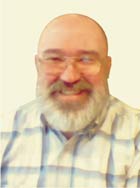Contents: 2024 | 2023 | 2022 | 2021 | 2020 | 2019 | 2018 | 2017 | 2016 | 2015 | 2014 | 2013 | 2012 | 2011 | 2010 | 2009 | 2008 | 2007 | 2006 | 2005 | 2004 | 2003 | 2002 | 2001
2010, 14
Multibubble acoustic cavitation: a mathematical model and physical similarity
language: Russian
received 23.08.2010, published 30.09.2010
Download article (PDF, 700 kb, ZIP), use browser command "Save Target As..."
To read this document you need Adobe Acrobat © Reader software, which is simple to use and available at no cost. Use version 4.0 or higher. You can download software from Adobe site (http://www.adobe.com/).
ABSTRACT
It is shown that the spatial distribution of erosive power density of the multibubble cavitation can be described as a function of coordinates of space and parameters of the wave, which causes this cavitation. To that end, it is necessary to calculate the values of two special metrics for each point in space. The first of these metrics will help to find average time of arrival to this point the pressure perturbation from pulsations of all the bubbles, The second one is the average attenuation values of these perturbations. Assuming multibubble cavitation as ergodic process, the integral superposition of all pressure perturbations should be approximated by a periodic generalized function of the pressure pulse on the surface of a single bubble with an oscillation period equal to the period of harmonic wave. It makes relatively easy numerical simulation of the multibubble cavitation dynamics and allows to compare quantitatively the results of its physicochemical impact when using the theory of physical similarity. Also, it allows to perform technical calculations for design of technological devices with a sufficient degree of accuracy and reliability.
Keywords: multibubble acoustic cavitation, numerical simulation, physical similarity.
16 pages, 8 figures
Сitation: S. Shestakov. Multibubble acoustic cavitation: a mathematical model and physical similarity. Electronic Journal “Technical Acoustics”, http://www.ejta.org, 2010, 14.
REFERENCES
1. Mettin R., Koch Ph. and Lauterborn W. Modeling acoustic cavitation with bubble redistribution // 6-th International Symposium on Cavitation, Wageningen, 2006.
2. Шестаков С. Д. Основы технологии кавитационной дезинтеграции.- М: ЕВА-пресс, 2001.
3. Margulis M. A. Sonochemistry and Cavitation.- London: Gordon & Breach, 1995.
4. Dezhkunov N. V. et al. Enhancement of sonoluminescence emission from a multibabble cavitation zone // Ultrasonics Sonochemistry, 7, 2000.
5. Nigmatulin R. I. et al. The theory of supercompression of vapor bubbles and nano-scale thermonuclear fusion // Physics of Fluids, 17, 107106, 2005.
6. Маргулис М. А. Сонолюминесценция // УФН, 170, 263, 2000.
7. Matula T. J. et al. Comparison of multibubble and single-bubble sonoluminescence spectra // Phys. Rev. Lett., 75, 1995.
8. Flannigan D. and Suslik K. Plasma formation and temperature measurement during single-bubble cavitation // Letters to Nature, 434, 2005.
9. Шестаков С. Д. Исследование возможности непараметрического усиления многопузырьковой кавитации // Прикладная физика, 6, 2008.
10. Ланин В. Л., Дежкунов Н. В. и Томаль В. С. Приборное обеспечение измерения параметров ультразвуковых воздействий в технологических процессах // Технология и конструирование в электронной аппаратуре, 2, 2008.
11. Дежкунов Н. В., Игнатенко П. В. и Котухов А. В. Оптимизация активности кавитации в импульсно модулированном ультразвуковом поле // Электронный журнал «Техническая акустика», http://www.ejta.org, 2007, 16.
12. Krefting D., Mettin R. and Lauterborn W. High-speed observation of acoustic cavitation erosion in multibubble systems // Ultrasonics Sonochemistry, 11, 2004.
13. Mawson R., Knoerzer K. A brief history of the application of ultrasonics in food processing // 19-th ICA Congress, Madrid: 2007.
14. Knapp R., Daily J. and Hammitt F. Cavitation. NY: McGraw Book Company, 1970. (Кнэпп Р., Дейли Дж. и Хэммит Ф. Кавитация.- М: Мир, 1974).
15. Физика и техника мощного ультразвука. Мощные ультразвуковые поля // под ред. Л. Д. Розенберга.- М: Наука, 1968.
16. Подобрий Г. М. и др. Теоретические основы торпедного оружия. М: Воениздат, 1969.
17. Klotz А. R., Hynynen K. Simulations of the Devin and Zudin modified Rayleigh-Plesset equations to model bubble dynamics in a tube // Electronic Journal “Technical Acoustics”, http://www.ejta.org, 2010, 11.
18. Мельников П. И., Макаренко В. Г. и Макаренко М. Г. Достижение высоких температур при сжатии парового пузырька // ПМТФ, т. 45, 4, 2004.
19. Gaitan D., Tessien R. and Hiller R. Pressure pulses from transient cavitation in high-q resonators // 19-th ICA Congress, Madrid: 2007.
20. Floris F. M. Modeling the Cavitation Free Energy // The Journal of Physical Chemistry, 109 (50), B2005, 24061-24070.
21. Patent EP 1810744, 2007.
22. Лавриненко О. В., Савина Е. И. и Леонов Г. В. Моделирование механо-физико-химических эффектов в процессе схлопывания кавитационных полостей // Ползуновский вестник, 3, 2007.
23. Кедринский В. К. Динамика зоны кавитации при подводном взрыве вблизи свободной поверхности // ПМТФ, 5, 1975.
24. Шестаков С. Д., Бефус А. П. Формулирование критерия подобия сонохимических реакторов при обработке сред, не обеспечивающих акустического резонанса, Деп. в ВИНИТИ РАН, №840-В2008.
25. Шестаков С. Д. О распределении плотности потенциальной энергии многопузырьковой кавитации относительно порождающей ее гармонической волны // Сб. тр. ХVI сессии Росс. акуст. об-ва, т.1.- М.: ГЕОС, 2005.
26. Красуля О. Н., Шленская Т. В. и Шестаков С. Д. Опыт использования сонотехнологий в пищевой промышленности // Сб. тр. ХХII сессии Росс. акуст. об-ва.- М.: ГЕОС, 2010.
27. Lahey R. T., Taleyarkhan R. P. and Nigmatulin R. I. Sonofusion technology revisted // Nuclear Eng. and Design,V.237, 2007.
28. http://www.reltec.biz/ru.
29. http://www.hielscher.com.
 |
Sergey Shestakov - doctor of Technical Sciences, Professor at Moscow State University of Technology and Management, Chairman of regional branch of the Russian Acoustical Society. Author of scientific discovery in the field of physics, two monographs, 100 scientific papers, 50 patented inventions. Research interests: systems analysis and mathematical modeling of ultrasonic technologies and related issues. e-mail: sdsh(at)mail.ru |
